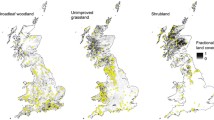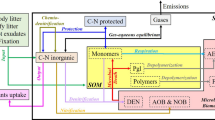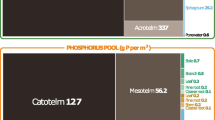Abstract
Texture is an important influence on organic matter (SOM) dynamics in upland soils but little is known about its role in riverine soils. We hypothesized that texture might be especially important to SOM accumulation in young alluvial soils. We combined the soil component of the CENTURY ecosystem model, which uses sand, silt, and clay concentration as primary variables, with a simple simulation model of fluvial deposition, and forest production to predict changes in soil carbon (C) and nitrogen (N) during primary succession on floodplains and terraces of the Queets River, Washington. Simulated soil C accumulated to a plateau of about 4000 g m−2 at 110 years, closely matching observed patterns in an empirical chronosequence. Although direct fluvial OM deposition had only a small and short-lived influence on soil C, fluvial silt and clay deposition were an important influence on equilibrium C. The model underestimated soil N by about 35%, which appears to be due to failure of the model to account for N enrichment of an OM pool after its initial formation. These results suggest that basic influences on SOM retention in these young soils are not functionally different than those that apply to upland soils, but occur within highly dynamic physical contexts. Overbank deposition of silt and clay establishes a basic capacity for SOM retention. SOM, in turn, facilitates N retention. In this way, silt and clay are instrumental in propagating N forward from N-fixing red alder (Alnus rubra) stands to mature conifer forests that are frequently N-limited.








Similar content being viewed by others
References
Antoine ME. 2004. An ecophysiological approach to quantifying nitrogen fixation by Lobaria oregana. Bryologist 107:82–7.
Bechtold JS, Edwards RT, Naiman RJ. 2003. Biotic versus hydrologic control over seasonal nitrate leaching in a floodplain forest. Biogeochemistry 63:53–71.
Bechtold JS, Naiman RJ. Fluvial sediments control floodplain soil biogeochemistry. Ecol Monogr (unpublished).
Bennett S, Simon A. 2004. Riparian vegetation and fluvial geomorphology. Washington DC: American Geophysical Union.
Berntson GM, Aber JD. 2000. Fast nitrate immobilization in N saturated temperate forest soils. Soil Biol Biochem 32:151–6.
Binkley D, Cromack K, Baker DD. 1994. Nitrogen fixation by red alder: biology, rates and controls. In: Hibbs DE, DeBell DS, Tarrant RF, Eds. The biology and management of red alder. Corvallis, OR: Oregon State University Press. p 57–72.
Boyer EW, Alexander RB, Parton WJ, Li CS, Butterbach-Bahl K, Donner SD, Skaggs RW, Del Gross SJ. 2006. Modeling denitrification in terrestrial and aquatic ecosystems at regional scales. Ecol Appl 16:2123–42.
Burt R, Alexander EB. 1996. Soil development on moraines of Mendenhall Glacier, southeast Alaska 2. Chemical transformations and soil micromorphology. Geoderma 72:19–36.
Carter V, Dale T. 1974. Topsoil and civilization, revised edition. Norman, OK: University of Oklahoma Press.
Chapin FS, Matson P, Mooney HA. 2002. Principles of terrestrial ecosystem ecology. New York, NY: Springer-Verlag.
Chen H, Harmon ME, Sexton J, Fasth B. 2002. Fine-root decomposition and N dynamics in coniferous forests of the Pacific Northwest, USA. Can J For Res 32:320–31.
Clinton SM, Edwards RT, Naiman RJ. 2002. Forest-river interactions: influence on hyporheic dissolved organic carbon concentrations in a floodplain forest. J Am Water Res Assoc 38:619–31.
Compton JE, Church MR, Larned ST, Hogsett WE. 2003. Nitrogen export from forested watersheds in the Oregon Coast Range: the role of N-2-fixing red alder. Ecosystems 6:773–85.
Corenblit D, Tabacchi E, Steiger J, Gurnell AM. 2007. Reciprocal interactions and adjustments between fluvial landforms and vegetation dynamics in river corridors: a review of complementary approaches. Earth-Sci Rev 84:56–86.
Correll DL. 1997. Buffer zones and water quality protection: general principles. In: Haycock N, Burt T, Goulding K, Pinay G, Eds. Buffer zones: their processes and potential in water protection. Harpenden, UK: Quest Environmental. p 7–20.
Costa E Silva J, Wellendorf H, Pereira H. 1998. Clonal variation in wood quality and growth in young Sitka Spruce (Picea sitchensis (Bong.) Carr.): estimation of quantitative genetic parameters and index selection for improved pulpwood. Silvae Genetica 47:20–33.
Darke AK, Walbridge MR. 2000. Al and Fe biogeochemistry in a floodplain forest: implications for P retention. Biogeochemistry 51:1–32.
Davidson EA, Chorover J, Dail DB. 2003. A mechanism of abiotic immobilization of nitrate in forest ecosystems: the ferrous wheel hypothesis. Global Change Biol 9:228–36.
Domenach AM, Moiroud A, Jocteurmonrozier L. 1994. Leaf carbon and nitrogen constituents of some actinorhizal tree species. Soil Biol Biochem 26:649–53.
Edmonds RL, Blew RD. 1997. Trends in precipitation and stream chemistry in a pristine old-growth forest watershed, Olympic National Park, Washington. J Am Water Res Assoc 33:781–93.
Edmonds RL, Vogt DJ, Sandberg DH, Driver CH. 1986. Decomposition of Douglas-fir and red alder wood in clear-cuttings. Can J For Res 16:822–31.
Egli M, Wernli M, Kneisel C, Haeberli W. 2006. Melting glaciers and soil development in the proglacial area Morteratsch (Swiss Alps): I. Soil type chronosequence. Arct Antarct Alp Res 38:499–509.
Fitzhugh RD, Lovett GM, Venterea RT. 2003. Biotic and abiotic immobilization of ammonium, nitrite, and nitrate in soils developed under different tree species in the Catskill Mountains, New York, USA. Global Change Biol 9:1591–601.
Franklin JF, Dyrness CT. 1973. Natural vegetation of Oregon and Washington. Corvallis, OR: Oregon State University Press.
Gaudinski JB, Trumbore SE, Davidson EA, Zheng SH. 2000. Soil carbon cycling in a temperate forest: radiocarbon-based estimates of residence times, sequestration rates and partitioning of fluxes. Biogeochemistry 51:33–69.
Gill RA, Jackson RB. 2000. Global patterns of root turnover for terrestrial ecosystems. New Phytol 147:13–31.
Gompertz B. 1825. On the nature of the function of the law of human mortality and a new mode of determining contingencies. Philos Trans R Soc London 115:513–83.
Groffman PM, Butterbach-Bahl K, Fulweiler RW, Gold AJ, Morse JL, Stander EK, Tague C, Tonitto C, Vidon P. 2009. Challenges to incorporating spatially and temporally explicit phenomena (hotspots and hot moments) in denitrification models. Biogeochemistry 93:49–77.
Gurnell A, Petts G. 2006. Trees as riparian engineers: the Tagliamento River, Italy. Earth Surf Proc Land 31:1558–74.
Harrison KG, Post WM, Richter DD. 1995. Soil carbon turnover in a recovering temperate forest. Global Biogeochem Cycles 9:449–54.
Hedin LO, von Fischer JC, Ostrom NE, Kennedy BP, Brown MG, Robertson GP. 1998. Thermodynamic constraints on nitrogen transformations and other biogeochemical processes at soil-stream interfaces. Ecology 79:684–703.
Hessl AE, Milesi C, White MA, Peterson DL, Keane RE. 2004. Ecophysiological parameters for Pacific Northwest trees. Pacific Northwest Research Station: USDA Forest Service. p 20.
Hupp CR, Osterkamp WR. 1996. Riparian vegetation and fluvial geomorphic processes. Geomorphology 14:277–95.
Ittekkot V, Laane RWPM. 1991. Fate of riverine particulate organic matter. In: Degens E, Kempe S, Richey J, Eds. Biogeochemistry of major world rivers. Chichester, UK: John Wiley and Sons. p 233–43.
Jenny H. 1941. Factors of soil formation, a system of quantitative pedology. New York, NY: McGraw-Hill.
Johnson DW, Cheng W, Burke IC. 2000. Biotic and abiotic nitrogen retention in a variety of forest soils. Soil Sci Soc Am J 64:1503–14.
Joint Research Centre, E.C. 2006. Simlab 2.2.
Junk WJ, Bayley PB, Sparks RE. 1989. The flood pulse concept in river-floodplain systems. In: Dodge D, Ed. Proceedings of the international large river symposium. Can. Spec. Publ. Fisheries and Aquatic Sciences. p 106.
Kalliola R, Salo J, Puhakka M, Rajasilta M. 1991. New site formation and colonizing vegetation in primary succession on the western Amazon floodplains. J Ecol 79:877–901.
Kirschbaum MUF, Paul KI. 2002. Modelling C and N dynamics in forest soils with a modified version of the CENTURY model. Soil Biol Biochem 34:341–54.
Latterell JJ, Bechtold JS, O’Keefe TC, Van Pelt R, Naiman RJ. 2006. Dynamic patch mosaics and channel movement in an unconfined river valley of the Olympic Mountains. Freshwat Biol 51:523–44.
Latterell JJ, Naiman RJ. 2007. Source and dynamics of large logs in a temperate floodplain river. Ecol Appl 17:1127–41.
McClain ME, Boyer EW, Dent CL, Gergel SE, Grimm NB, Groffman PM, Hart SC, Harvey JW, Johnston CA, Mayorga E, McDowell WH, Pinay G. 2003. Biogeochemical hot spots and hot moments at the interface of terrestrial and aquatic ecosystems. Ecosystems 6:301–12.
McClain ME, Richey JE, Brandes JA, Pimentel TP. 1997. Dissolved organic matter and terrestrial-lotic linkages in the central Amazon basin of Brazil. Global Biogeochem Cycles 11:295–311.
McCreary FR. 1975. Soil survey of Jefferson County area, Washington. Washington, DC: USDA, Soil Conservation Service, Washington Agricultural Experiment Station.
Means JE, Hansen HA, Koerper GJ, Alaback PB, Klopsch MW. 1994. Software for computing plant biomass–BIOPAK users guide. Portland, OR: U.S. Department of Agriculture, Forest Service, Pacific Northwest Research Station. p 180.
Metherell AK, Harding LA, Cole CV, Parton WJ. 1993. CENTURY soil organic matter model environment technical documentation, agroecosystem version 4.0. Fort Collins, CO, USA: USDA-ARS. p 245.
Microsoft. 2003. Microsoft Excel 2003. Redmond, WA: Microsoft Corporation.
Morozova GS, Smith ND. 2003. Organic matter deposition in the Saskatchewan River floodplain (Cumberland Marshes, Canada): effects of progradational avulsions. Sed Geol 157:15–29.
Nadelhoffer KJ, Raich JW. 1992. Fine root production estimates and belowground carbon allocation in forest ecosystems. Ecology 73:1139–47.
Naiman RJ, Sedell JR. 1979. Characterization of particulate organic matter transported by some Cascade mountain streams. J Fish Res Board Can 36:17–31.
Nalder IA, Wein RW. 2006. A model for the investigation of long-term carbon dynamics in boreal forests of western Canada—I. Model development and validation. Ecol Model 192:37–66.
Nanson GC, Croke JC. 1992. A genetic classification of floodplains. Geomorphology 4:459–86.
National Climate Data Center. 2005. Local climatological data, annual summary with comparative data, Quillayute Airport Washington (UIL). Asheville, NC: National Oceanic and Atmospheric Administration, National Climate Data Center. p 6.
Neff JC, Asner GP. 2001. Dissolved organic carbon in terrestrial ecosystems: synthesis and a model. Ecosystems 4:29–48.
Nelson PN, Baldock JA, Oades JM. 1993. Concentration and composition of dissolved organic carbon in streams in relation to catchment soil properties. Biogeochemistry 19:27–50.
O’Connor JE, Jones MA, Haluska TL. 2003. Flood plain and channel dynamics of the Quinault and Queets Rivers, Washington, USA. Geomorphology 51:31–59.
O’Keefe TC, Naiman RJ. 2006. The influence of forest structure on riparian litterfall in a Pacific Coastal rain forest. Can J For Res 36:2852–63.
Parton WJ, Schimel DS, Cole CV, Ojima DS. 1987. Analysis of factors controlling soil organic matter levels in Great Plains grasslands. Soil Sci Soc Am J 51:1173–9.
Pike LH. 1978. The importance of epiphytic lichens in mineral cycling. Bryologist 81:247–57.
Pinay G, Gumiero B, Tabacchi E, Gimenez O, Tabacchi-Planty AM, Hefting MM, Burt TP, Black VA, Nilsson C, Iordache V, Bureau F, Vought L, Petts GE, Decamps H. 2007. Patterns of denitrification rates in European alluvial soils under various hydrological regimes. Freshwat Biol 52:252–66.
Poff NL, Allan JD, Bain MB, Karr JR, Prestegaard KL, Richter BD, Sparks RE, Stromberg JC. 1997. The natural flow regime: a paradigm for river conservation and restoration. Bioscience 47:769–84.
Post WM, Kwon KC. 2000. Soil carbon sequestration and land-use change: processes and potential. Global Change Biol 6:317–27.
Poulton SW, Raiswell R. 2002. The low-temperature geochemical cycle of iron: from continental fluxes to marine sediment deposition. Am J Sci 302:774–805.
Ritzenthaler EAS. 1998. Biogeochemistry and hydrology of a forested floodplain backchannel: riparian and hyporheic interactions. MS Thesis, College of Forest Resources, University of Washington, Seattle, WA, 79 p.
Robertson KM, Augspurger CK. 1999. Geomorphic processes and spatial patterns of primary forest succession on the Bogue Chitto River, USA. J Ecol 87:1052–63.
Salo J, Kalliola R, Hakkinen I, Makinen Y, Niemela P, Puhakka M, Coley PD. 1986. River dynamics and the diversity of Amazon lowland forest. Nature 322:254–8.
Schumm SA. 1977. The fluvial system. New York, NY: John Wiley & Sons.
Smith P, Powlson DS, Smith JU, Elliott ET. 1997. Evaluation and comparison of soil organic matter models—preface. Geoderma 81:1–225.
Sobol’ IM. 1993. Sensitivity estimates for Non-linear Mathematical Models. Math Model Comput Exp 1:407–14.
Spink A, Sparks RE, Van Oorschot M, Verhoeven JTA. 1998. Nutrient dynamics of large river floodplains. Regul Rivers Res Manage 14:203–16.
Steiger J, Gurnell AM, Petts GE. 2001. Sediment deposition along the channel margins of a reach of the middle River Severn, UK. Regul Rivers Res Manage 17:443–60.
Syvitski JPM, Vorosmarty CJ, Kettner AJ, Green P. 2005. Impact of humans on the flux of terrestrial sediment to the global coastal ocean. Science 308:376–80.
Tabor RW, Cady WM. 1978. Geologic map of the Olympic Peninsula. U.S. Geological Survery Miscellaneous Investigations Series Map I, 994 p.
Thackray GD. 2001. Extensive early and middle Wisconsin glaciation on the western Olympic Peninsula, Washington, and the variability of Pacific moisture delivery to the northwestern United States. Quat Res 55:257–70.
Tockner K, Bunn S, Quinn GP, Naiman RJ, Stanford JA, Gordon C. 2007. Floodplains: critically threatened ecosystems. In: Polunin NC, Ed. The state of the world’s ecosystems. Cambridge: Cambridge University Press.
Trumbore SE. 1993. Comparison of carbon dynamics in tropical and temperate soils using radiocarbon measurements. Global Biogeochem Cycles 7:275–90.
U.S. Geological Service. 2006. National water information system. Availabile online at http://waterdata.usgs.gov/wa/nwis/inventory/?site_no-12040500. Accessed June 10, 2006.
Uselman S, Qualls RG, Lilienfein J. 2007. Fine root production across a primary successional ecosystem chronosequence at Mt. Shasta, California. Ecosystems 10:703–17.
Van Cleve K, Viereck LA, Dyrness CT. 1996. State factor control of soils and forest succession along the Tanana River in interior Alaska, USA. Arct Alp Res 28:388–400.
Van Pelt R, O’Keefe TC, Latterell JJ, Naiman RJ. 2006. Riparian forest stand development along the Queets River in Olympic National Park, Washington. Ecol Monogr 76:277–98.
Walker LR, del Moral R. 2003. Primary succession and ecosystem rehabilitation. Cambridge, UK: Cambridge University Press.
Acknowledgments
We thank Robert Edmonds and Kristiina Vogt for useful comments on early drafts. Research support was received from the Andrew W. Mellon Foundation, the National Science Foundation and the UW School of Aquatic and Fishery Sciences.
Author information
Authors and Affiliations
Corresponding author
Additional information
Author Contributions
Scott Bechtold (corresponding author) performed the data analysis, constructed the model, and wrote the paper. Robert Naiman contributed to the overall study design, suggested improvements to the model, and edited the manuscript.
Rights and permissions
About this article
Cite this article
Bechtold, J.S., Naiman, R.J. A Quantitative Model of Soil Organic Matter Accumulation During Floodplain Primary Succession. Ecosystems 12, 1352–1368 (2009). https://doi.org/10.1007/s10021-009-9294-9
Received:
Accepted:
Published:
Issue Date:
DOI: https://doi.org/10.1007/s10021-009-9294-9




